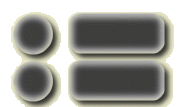
|
|

|
|
| Venue |
The conference will be held in Hotel Sorea Slnava, situated about 400m from the Vah river and about 2km from the center of Piestany. You can find here map of Piestany with highlighted important places.
Address:
Hotel Slnava
Hlboka 47
921 01 Piestany
Phone:
+421 33 7726071
+421 33 7726992
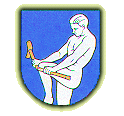
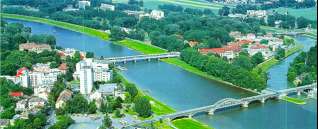 Piestany is a world-famous spa town located in the lower region of the Vah river in western Slovakia, surrounded on the east by the mountain range of Povazsky Inovec. The name Piestany is derived from the Latin "paskan" (sand). The town was named so by the earliest settlers probably because their
settlements were built on the sand deposited by the waters of the Vah River.
Piestany is a world-famous spa town located in the lower region of the Vah river in western Slovakia, surrounded on the east by the mountain range of Povazsky Inovec. The name Piestany is derived from the Latin "paskan" (sand). The town was named so by the earliest settlers probably because their
settlements were built on the sand deposited by the waters of the Vah River.
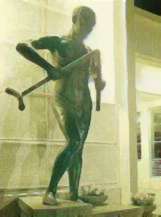 The spa has a legend history, which claims that the healing powers of the waters were discovered when a big beautiful and lame peacock dragged itself to the banks of the river below the village of Banka and was miraculously cured. Another tale says that the medical effects of the local waters were discovered by the legions of ancient Rome on their northward marches during the reign of the Roman Emperor Marcus Aurelius Antoninus. The presence of these soldiers has been verified from specific inscriptions on rocks on the grounds of Trencin castle, situated a little to the north. It was said that the Romans dug holes in areas close to the Vah, whereupon hot water started to flow; the soldiers then immersed themselves in the water, and discovered that it had an almost immediate curative effect. Word then spread, and so began this truly magnificent spa complex.
The spa has a legend history, which claims that the healing powers of the waters were discovered when a big beautiful and lame peacock dragged itself to the banks of the river below the village of Banka and was miraculously cured. Another tale says that the medical effects of the local waters were discovered by the legions of ancient Rome on their northward marches during the reign of the Roman Emperor Marcus Aurelius Antoninus. The presence of these soldiers has been verified from specific inscriptions on rocks on the grounds of Trencin castle, situated a little to the north. It was said that the Romans dug holes in areas close to the Vah, whereupon hot water started to flow; the soldiers then immersed themselves in the water, and discovered that it had an almost immediate curative effect. Word then spread, and so began this truly magnificent spa complex.
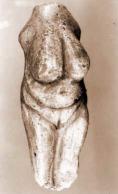 The importance of this area, with picturesque surroundings, was determined long before the town had been founded by the existence of thermal springs. In the Ice-Age of the palaeolith an unfreezing part of the river near hot springs was used by animals as a watering place. Approximately 25 000 years ago it led to a permanent settlement of the surrounding hills by groups of primeval hunters. The world-famous artifact from this period is the statuette of the so called Venus of Moravany carved from a mammoth tusk by a primeval artist.
The importance of this area, with picturesque surroundings, was determined long before the town had been founded by the existence of thermal springs. In the Ice-Age of the palaeolith an unfreezing part of the river near hot springs was used by animals as a watering place. Approximately 25 000 years ago it led to a permanent settlement of the surrounding hills by groups of primeval hunters. The world-famous artifact from this period is the statuette of the so called Venus of Moravany carved from a mammoth tusk by a primeval artist.
During the period of the greatest expansion of The Roman Empire in the 1-4 centuries A.D. this area was the center of the principality of Germanic Quades. A part of the archeological excavations of the so called Dukes graves is exhibited in the Balneological Museum of Piestany.
In the 5th and 6th centuries this area was settled by Slavonic tribes. The Great Moravian period connected with the activities of the missionaries St.Cyril and St.Metod is represented by the archeological site of the Dukes yard in Kostolec.
Around the year 1000 when the Hungarian state was formed by the king Steven I. Slovakia had gradually become its part. The peasant village Piestany is likely to have been founded in this period. It was in the area of the so called Old Piestany situated between the river Vah and the Dubova stream that industrious Slovak settlers found their permanent home. They tilled surrounding fertile fields. The village of Piestany was ruled by the Royal Castle Bana. Historians have established that sometime between the 11th and 12th centuries a monastery existed in "Old Piestany". The original site can be seen today in the garden of one of the houses on Defusanska Street. Piestany was first mentioned in the Charter of Zobor issued by Koloman I. which dates from the year 1113.
After the Tartar invasion in 1241 a stone castle Tematin was built and it was owned by the feudal family of Huntapoznan. The village of Piestany also became a part of the Tematin demesne. Another owner was the "Mighty lord of Vah and Tatras" Matus Cak Trenciansky and after him for two centuries the counts of Ljlak. In the 16th century the counts family Turzo became the owner of Piestany. In the 17th century Piestany was owned by the families of Bercuni and Forgac.
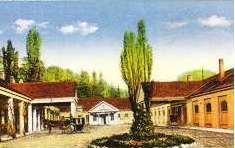 In the 16th century about two kilometers to the south of Old Piestany opposite the thermal springs a spa hamlet of Teplice was founded. In this period news about curative effects of local springs began to spread to neighboring countries. In the 17th century a priest Adam Trajan wrote a Latin ode Saluberrimae Pistinienses Thermae. The ill cured themselves in hot water holes in a primitive way without medical supervision.
In the 16th century about two kilometers to the south of Old Piestany opposite the thermal springs a spa hamlet of Teplice was founded. In this period news about curative effects of local springs began to spread to neighboring countries. In the 17th century a priest Adam Trajan wrote a Latin ode Saluberrimae Pistinienses Thermae. The ill cured themselves in hot water holes in a primitive way without medical supervision.
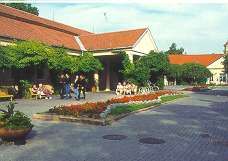 In the 18th century Piestany and the local spa came under the rule the House of Erdodi. At the end of the 18th century the commissioned first two wooden spa facilities in which diseases were treated by thermal water and mud on the Spa Island. In the 19th century the stone Napoleonic Spa facilities, which are still used, were built.
In the 18th century Piestany and the local spa came under the rule the House of Erdodi. At the end of the 18th century the commissioned first two wooden spa facilities in which diseases were treated by thermal water and mud on the Spa Island. In the 19th century the stone Napoleonic Spa facilities, which are still used, were built.
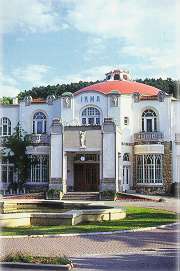 A great boom of the Piestany spa came about at the end of the 19th century when the then owner count Erdodi leased the spa to the entrepreneurial family of Winter. Ludovit Winter helped to build a number of spa facilities as Kursalon (Spa Hall), a beautiful hotel Thermia Palace and spa Irma, thermal swimming pool Eva and so on. His brother Imrich Winter made it possible that during the years 1918-38 Piestany became world famous not only for its spa and recreation opportunities but also as a cultural and sports center. The social development of Piestany and the construction of the hotels, pensions and family houses was shared by local entrepreneurs, small businessmen, spa doctors and so on.
A great boom of the Piestany spa came about at the end of the 19th century when the then owner count Erdodi leased the spa to the entrepreneurial family of Winter. Ludovit Winter helped to build a number of spa facilities as Kursalon (Spa Hall), a beautiful hotel Thermia Palace and spa Irma, thermal swimming pool Eva and so on. His brother Imrich Winter made it possible that during the years 1918-38 Piestany became world famous not only for its spa and recreation opportunities but also as a cultural and sports center. The social development of Piestany and the construction of the hotels, pensions and family houses was shared by local entrepreneurs, small businessmen, spa doctors and so on.
After the World War II. Piestany became a town. Under the Communist regime the construction of the town and spa continued. In accordance with the plan of municipal development numerous housing estates and family houses were built. Further development of cultural life was facilitated by the construction of the House of Arts. On the Spa Island a large balneotherapeutics complex of facilities Balnea was built.
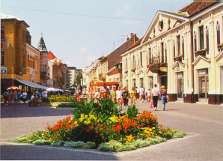 At present, Piestany is the most important spa town in Slovakia. Extensive reconstruction work has been done on old town buildings and every summer, the town braces itself for a wave of tourists. Open air concerts and films, water-skiing competitions, horse riding stables and a lively nightlife make this town more than just a spa holiday. Whether walking in one of Piestany's quiet, shaded parks or sailing on the river Vah or Lake Slnava, visitors have always rated Piestany as one of Slovakia's most beautiful and tourist-friendly destinations.
At present, Piestany is the most important spa town in Slovakia. Extensive reconstruction work has been done on old town buildings and every summer, the town braces itself for a wave of tourists. Open air concerts and films, water-skiing competitions, horse riding stables and a lively nightlife make this town more than just a spa holiday. Whether walking in one of Piestany's quiet, shaded parks or sailing on the river Vah or Lake Slnava, visitors have always rated Piestany as one of Slovakia's most beautiful and tourist-friendly destinations.
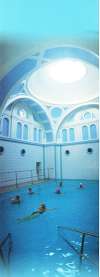 For a very long time therapeutic effects of Piestany's hot springs remained an unsolved mystery. Today it has already been proved that high temperature 67-69 C and as well as a suitable chemical composition of local spring water is conditioned by the geological stratification of the Povazsky Inovec. By the term thermal water we understand gypsum-sulphuric water containing hydrogen sulfide, cations Ca, Mg, Na, anion SO4, HCO3, Ce and H2S (hydrogen sulfide).
For a very long time therapeutic effects of Piestany's hot springs remained an unsolved mystery. Today it has already been proved that high temperature 67-69 C and as well as a suitable chemical composition of local spring water is conditioned by the geological stratification of the Povazsky Inovec. By the term thermal water we understand gypsum-sulphuric water containing hydrogen sulfide, cations Ca, Mg, Na, anion SO4, HCO3, Ce and H2S (hydrogen sulfide).
Another outstanding therapeutical source is sulfuric thermal mud, which is formed form tiny claylike particles carried by water to the vicinity of thermal wells. Owing to the long term impact of hot mineral water, which leaves in wells mineral and organic sediment, temperature and special thermophile bacteria the clay particles were changed to tiny butter like mud with outstanding curative properties.
Complex therapy in spa consists of hydrotherapy, mud warps, baths of physical therapy, therapeutic gymnastics, work therapy, nutritive therapy, kinesitherapy and if necessary of medication based on the latest notions and results of the Research Institute of Rheumatic Diseases.
| Other Information Sources |